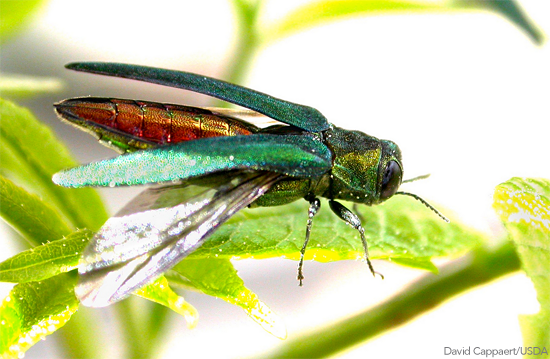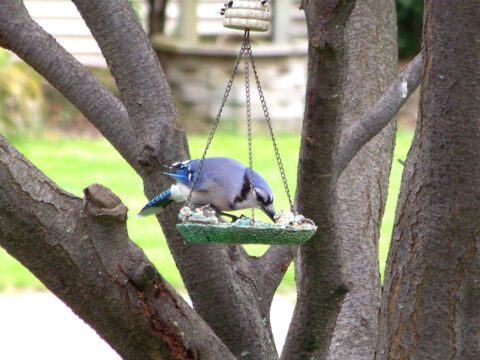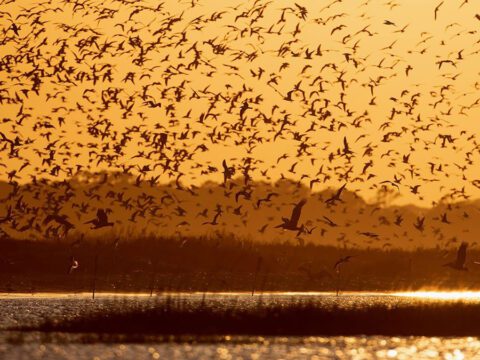Bored to Death: An Ecological Surprise From the Emerald Ash Borer
By Hugh Powell
July 15, 2010
When the invasion went public in 2002, aliens had been living quietly in Detroit for at least 10 years. They were found out when a group of forestry scientists investigated a curious die-off in ash trees. They collected a small green beetle that none of them could identify. Eventually, a beetle specialist in Slovakia pegged it as Agrilus planipennis, the emerald ash borer. It had never before been recorded outside its native range in easternmost Asia. By the end of the year it had killed an estimated 7 million ash trees in Michigan.
It’s now one of the most destructive forest pests ever seen in North America—comparable to diseases such as chestnut blight and Dutch elm disease. There are 16 ash species and an estimated 8 billion ash trees in North America, and all of them are susceptible. “It’s this entire group of common eastern forest trees that could potentially get wiped out,” said Walter Koenig, a senior researcher at the Cornell Lab. “There isn’t anything controlling this outbreak at the moment.”
The adults don’t look like much of a threat: pretty, half-inch-long beetles with glittering green backs. It’s the nondescript beige larvae that do the damage. Armies of them hatch from eggs laid on the bark and then spend a year or two chewing through the tree’s cambium. Sixty thousand can emerge from a single tree. They can kill an entire stand in five years. They hitch rides in nursery trees, cut logs, and firewood—one reason never to take firewood along with you on camping trips—and they’ve already reached as far as New Hampshire and West Virginia.
The emerald ash borer is a true invasive, like kudzu, zebra mussels, or European Starlings—a species that becomes untethered from the ecological constraints of its homeland and then proliferates.
In what may seem like cold comfort, their spread has at least caused a boom in food and nest sites for birds. In a recent study, a team led by Koenig gauged this ripple effect by pulling data from Project FeederWatch, a Cornell Lab citizen-science study that collects winter observations of feeder birds across North America.
The researchers chose areas of high, low, and no infestation, and compared FeederWatch reports of Downy, Hairy, and Red-bellied woodpeckers and White-breasted Nuthatches. They tested whether these bird species moved toward the increased food source, dispersed away from it, or showed up in higher numbers to nest in dead trees after the outbreak had moved on.
Their results indicated that Red-bellied Woodpeckers and White-breasted Nuthatches were more numerous in outbreak areas. The outbreaks didn’t seem to draw in birds, but those already living in the area showed evidence of higher reproduction and survival, perhaps because they benefited from the increased food supplies.
Modest though the response was, woodpeckers and nuthatches may be the ash trees’ best hope. One study found that woodpeckers could eat an average of 44 percent of the borer larvae at a site. But another study noted that very few native or introduced insect predators or parasites prey on the emerald ash borer.
And the insects have numbers on their side. “Woodpeckers can’t quite eat enough to keep up with them,” Koenig said. “Even if woodpeckers are eating 40, 50 percent of their young, that’s still an awful lot of emerald ash borers that are getting out there.”
At some point, insect predators or birds could step up their attacks on emerald ash borers and rein them in—nature does abhor a vacuum, after all. But for now, the increase in woodpeckers is the slimmest of silver linings. The most compelling take-home lesson is the ability of citizen science to aid scientists in a pinch. Koenig has used publicly collected data to answer similar questions about gypsy moths and sudden oak death. It’s a potent reminder of the irreplaceable role of citizen scientists when the scales are large and the stakes are high.

All About Birds
is a free resource
Available for everyone,
funded by donors like you
American Kestrel by Blair Dudeck / Macaulay Library





